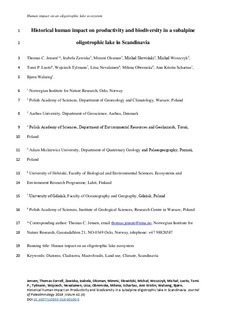Historical human impact on Productivity and biodiversity in a subalpine oligotrophic lake in Scandinavia
Jensen, Thomas Correll; Zawiska, Izabela; Oksman, Mimmi; Słowiński, Michał; Woszczyk, Michał; Luoto, Tomi P.; Tylmann, Wojciech; Nevalainen, Liisa; Obremska, Milena; Schartau, Ann Kristin; Walseng, Bjørn
Peer reviewed, Journal article
Accepted version

Åpne
Permanent lenke
http://hdl.handle.net/11250/2629343Utgivelsesdato
2019Metadata
Vis full innførselSamlinger
- Scientific publications [1392]
Originalversjon
10.1007/s10933-019-00100-5Sammendrag
We conducted a paleolimnological study to examine how changes in human activity interacted with climate to influence productivity and biodiversity over the past millennium in oligotrophic Lake Atnsjøen, SE Norway. The study included analyses of sediment geochemistry, subfossil diatoms and cladocerans, and macrofossils. Results were compared with the historical record of human activities in the catchment, pollen analysis and paleoclimate inferences from the lake. During the first 750 years of the record (1000–1750 CE), a time of relatively low human activity, lake productivity and biodiversity were strongly related to climate. During the Little Ice Age (1550–1800 CE), lake productivity and diatom diversity were constrained by cold climate. A century of climate warming (1780–1880 CE) initiated an increase in productivity. Accelerated human settlement after 1850 CE, however, had an even stronger impact on productivity, mediated by increased agriculture and/or forestry, which led to greater nutrient loading of the lake. Similarly, diatoms in the lake responded to the rise in temperature, but increasing human activity also had a moderate impact on the diatom community, which displayed weak signs of nutrient enrichment. From 1980 to 1990 CE onwards, lake productivity declined as a consequence of a recent decrease in human activity and changing land use. The human-induced increase in lake productivity starting ca. 1850 CE propagated through the food web and increased consumer productivity, as reflected by greater accumulation rates of cladocerans, trichopterans and turbellarians. The cladoceran community was likely under top-down control of fish, as indicated by changes in size structure and diversity. Our study showed that increasing human activity during the settlement period had a stronger impact on lake productivity than did climate. Furthermore, the slight human-mediated increase in nutrient loading had different impacts on productivity and biodiversity in the study lake. This study demonstrates that even relatively small changes in human activities in watersheds can have measurable impacts on nutrient-poor lakes.